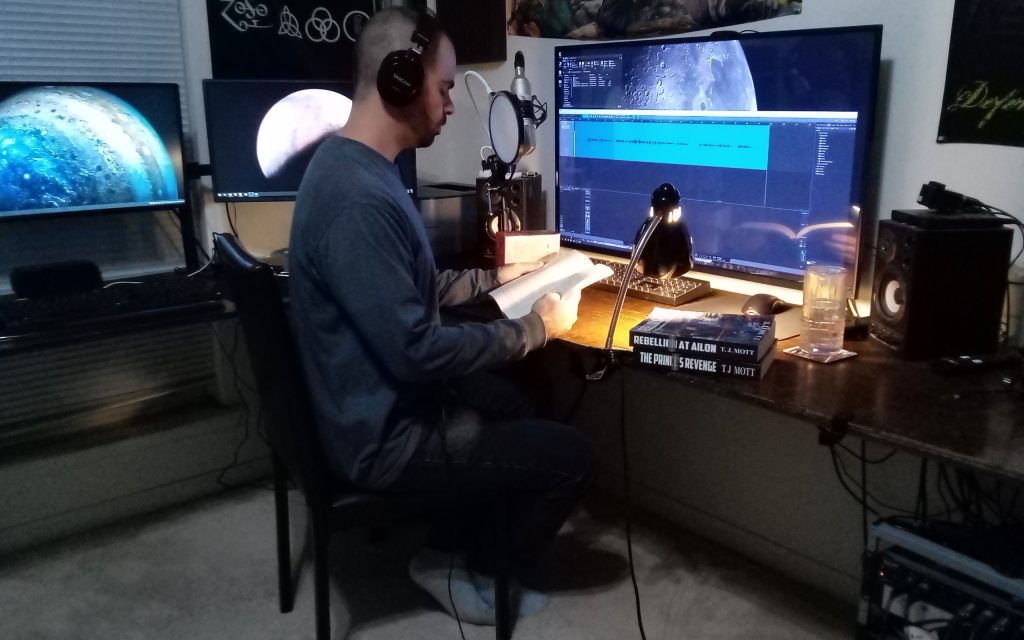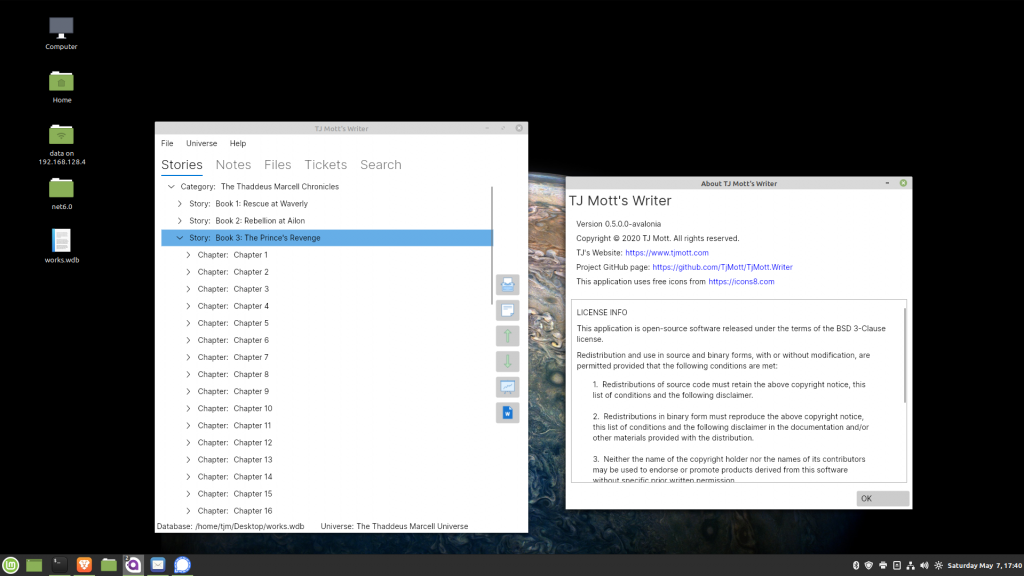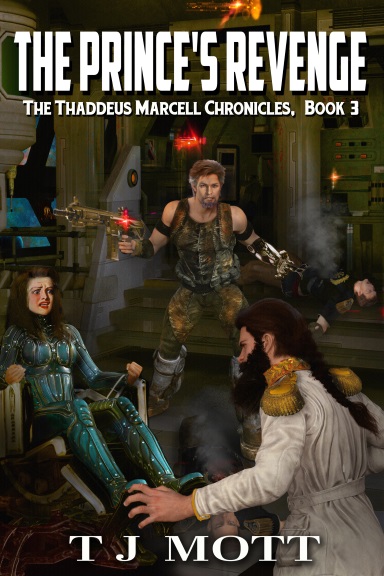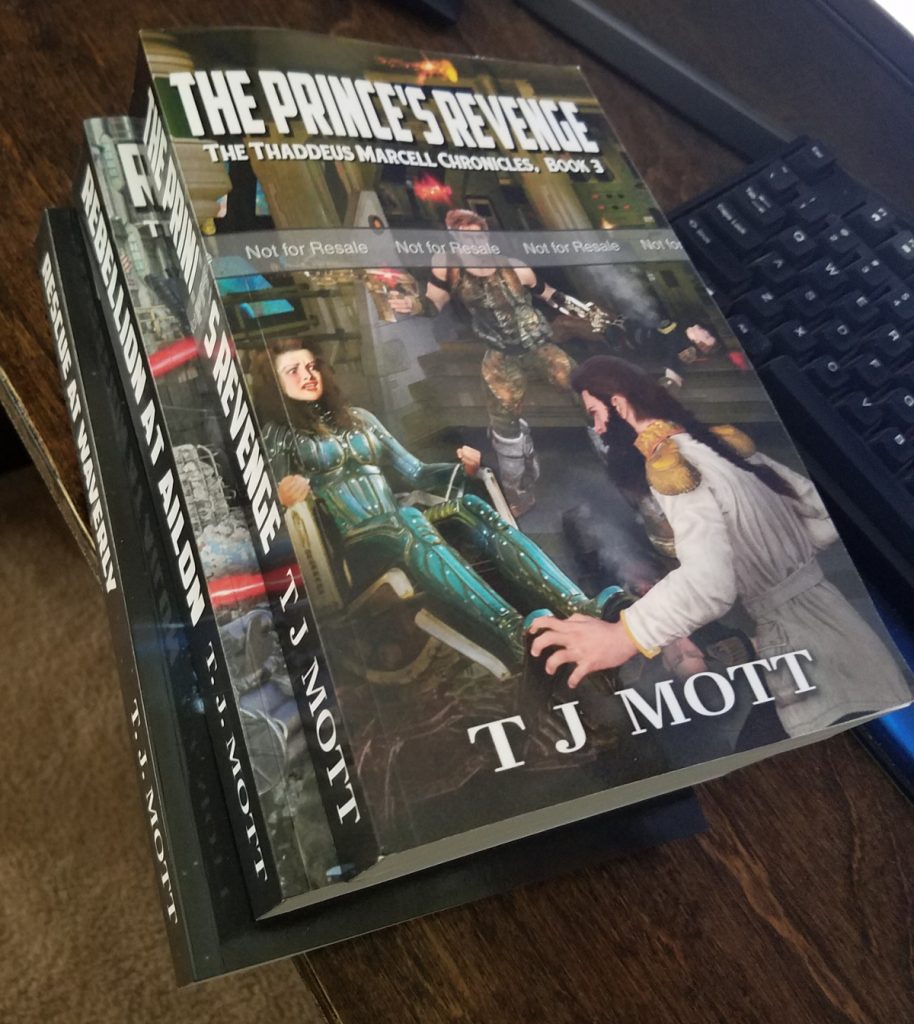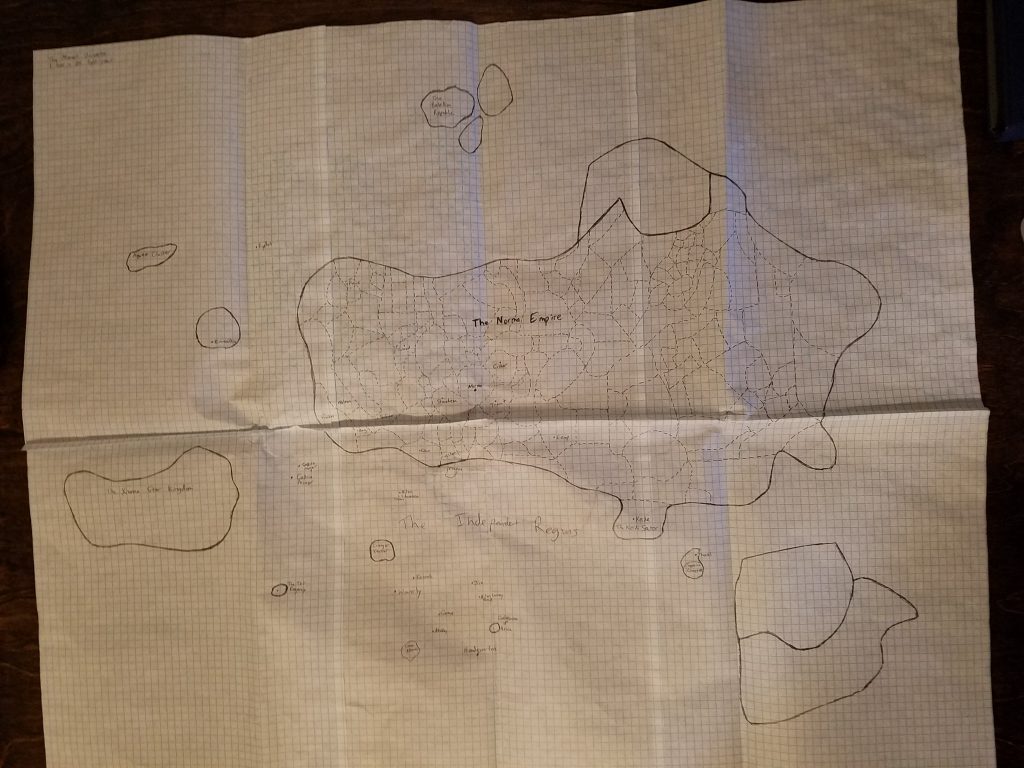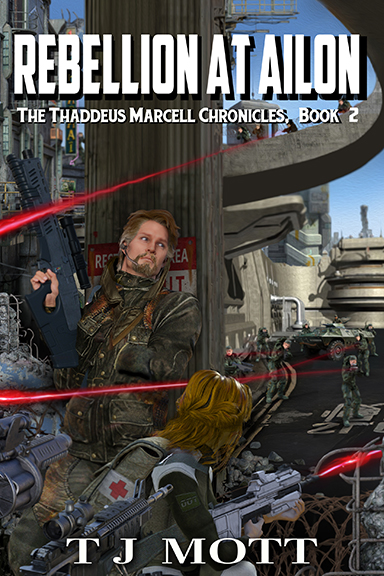Since releasing “Rescue at Waverly,” I’ve been submitting links to my work all over the Internet, to various promotional sites to get my name out there. And one of the things I constantly get asked by the online submission forms is some variation of “What inspired you to write?” I thought it might be fun to go into further detail and examine the history of my project, “The Thaddeus Marcell Chronicles.” And if you’ve ever considered writing your own fiction, maybe if you see how my process went, it’ll give you some ideas.
It All Began with Star Wars
When I was a kid, most of the fiction I read was from the Star Wars Expanded Universe, which was a collection of novels that were first released in the early 1990’s. I loved reading, and starting around the third grade, I spent much of my time in school ignoring my teachers and quietly reading Star Wars novels instead. At some point, for whatever reason, I decided I wanted to write science fiction, too. Why? I don’t know, it’s been so long I don’t remember. Maybe it’s the same nature that made me want to get into programming after spending so much time with computers as a kid, because I was exposed to Microsoft QBasic at around this same time. But that desire to write never really went away. As I grew older, it was fueled by my interests in math and physics, and it persisted even when I found myself working a full-time career in IT and software development.
Space Pirates
The first thing I remember trying to write was called “Space Pirates.” This was around fifth grade, maybe even a little earlier. It didn’t have much of a plot, but as I recall, it followed a crew of three pirates who worked around Earth space and somehow got involved in a ground war on Venus. I think I had 20 or 30 pages written, and then I must have gotten bored and moved on. (My manuscript might still be sitting on a rotten 3.5-inch floppy disk somewhere in an old abandoned Missouri farmhouse. I wouldn’t go looking for it though, floppies had lifespans measured in milliseconds and it’s now been twenty years or so.)
Killer Toy Robots
Around the same time, plus or minus a year, I remember working on a story involving a toy robot. It was given to some kid as a Christmas gift. However, it was accidentally programmed at the factory to be a military assassin, and once turned on, it escapes from its family and starts a robot revolution. I was young and impressionable, and I’m pretty sure I had just read “Tales of the Bounty Hunters” and regurgitated IG-88’s story in my own terms. Minus the parts where he uploaded a copy of his droid brain into the second Death Star’s main computer, of course.
Flight School
In sixth grade, I had my first “finished” work. We were supposed to write a short story for a school writing project. I wrote about a cadet in flight school who passed a flight test by using a highly-classified starfighter maneuver that he wasn’t supposed to know about, and so he got in a lot of trouble for it. But he was friends with the guy who’d developed it, who was a high-ranking wing commander or something. Most of the story was about the flight itself. (If I had to guess, I must have been reading the “X-Wing” series at the time.) I remember my teacher saying that it was very unique coming from someone my age. Sadly, I don’t have a copy of this anywhere, because I think it would be funny to re-read something I’d written at the end of elementary school.
The Triumvirate of Alpha Centauri
This story started in seventh or eighth grade, I believe, around 2001. I was in a typing class in school, but I somehow already knew how to type well. (Hey, I was born in the late 1980’s with a keyboard in one hand and an MS-DOS command reference in the other. I learned to type at such a young age that I don’t even remember it.) So instead of following my typing lessons, I mostly goofed off. At the time, the school had a computer lab full of Am5x86’s loaded with Windows 95 and something like 8 MB of RAM. And you didn’t dare go out to the Internet on them. Have you ever seen a 486-class PC try to load web pages with animated Flash advertisements and ten pop-ups per second? It wasn’t pretty. So when I wasn’t modifying minesweeper.ini files to give myself an impossible high score on every computer in the lab, I mostly goofed off by writing, because Word 95 ran fairly well once it actually finished loading.
During this class, I ended up writing a partial story about the three co-equal Presidents (a triumvirate) of Alpha Centauri, which was a former colony of nearby Earth. The main character was one of the Presidents, and he was also a General in charge of the military. Everything was perfect in Alpha Centauri and so the characters spent their free time building giant lasers and blowing up asteroids, or moving moons into different orbits with huge rocket motors just for fun, and things like that. In hindsight, it was pretty silly stuff. I didn’t have any goals, and the story was nothing more than a disjointed string of juvenile sci fi dreams written just to kill some class time.
While writing it, I never actually got past that string of silly and unconnected stories, but I had brainstormed how it should continue. According to my evil plans, partway through the story, a giant fleet emerges from hyperspace near Alpha Centauri. This obviously alarms the three Presidents, because hyperspace hadn’t been discovered yet, and this fleet is far larger than their own. Then, to their surprise, the fleet’s commander is an older, rougher version of the General, even though the General had been present for the entire story so far. They find out that he was abducted from Alpha Centauri 10 years ago, and the one who’d been President/General since then was actually some kind of secret robot clone who didn’t even know he was a robot. (A continuation of my robot theme, but he was never a Christmas gift who launched a robot revolution.)
Then the story was going to switch to a flashback. After his abduction, the original non-robot General discovered there was a huge human civilization out there, with hyperdrive and all kinds of advanced technology that Earth and Alpha Centauri never knew existed. He became a pirate and a mercenary, scouring the galaxy to find his way home. Along the way, he stockpiled weapons and technology to bring back so he could defend his home from the rest of the galaxy, and he became the leader of very powerful independent fleet. This returning General (he was named Thomas back then) was grizzled and battle-hardened, covered in scars and even with a cybernetic hand.
After the flashback ended, it would return to the present. Earth and Alpha Centauri were near the edges of a rapidly-expanding empire which they certainly couldn’t fight, not without help. Then there would be a massive interstellar war, and all the ships and weapons and technology that the General brought home would save the day.
Writing a Novel – For Real This Time!
My ideas got shelved for a long time, but I never forgot them. I still had the itch to write, but I never felt inspired enough to make a serious effort on anything. Finally, I had a dream which inspired my first published novel. It was short, just a tiny snippet I remembered after everything else faded, but it ultimately became a scene in “Rescue at Waverly” and was the seed that sort of defined the whole work for me. In this dream, a man is aboard a small transport, trying to reassure a woman he’d just rescued from an enemy starship. She was someone he once knew and loved, but somehow they’d been separated by life’s circumstances and he hadn’t seen her in many years.
For some reason this really struck me. But it wasn’t a story. It was just a snapshot, an image without any context. So I provided the context by dusting off some of my old backstory about the General from Alpha Centauri. I threw away the juvenile silliness about moon-sized rocket engines and blowing up asteroids for birthday celebrations. I also got rid of details that seemed cool when I was in junior high school, but really didn’t make sense to me anymore. Why was he replaced with a robot, and by whom? And how did nobody ever discover that a President was a robot? I couldn’t come up with any reasonable explanations so I changed him from a President and General from Alpha Centauri into a complete nobody from Earth, with no robot clone to replace him after he disappeared.
Even then, as some details began to take form, I wasn’t sure how to begin. Writing a novel with the intent to publish it is a big undertaking, and I never had any formal education in anything like this. I have a somewhat intuitive sense for writing and grammar just because of the sheer amount of reading I’ve done in life, but I never paid much attention during my English or writing classes in school. So during my 20’s, I probably wrote 20 different versions of the first chapter. Each time I finished it, I hated it, so I’d throw it away and start a new version from scratch, with different ideas and characters and starting points in mind. During one of these, I decided to begin the storyline well into his pirate/mercenary career, rather than starting at home before he was abducted. And that actually made things a lot easier.
Although I was frustrated by my lack of progress, looking back now, I realize how important it actually was. Writing takes practice. You can’t start cold and inexperienced and put out a well-written work on your first try. All of those thrown-away chapters were bad for various reasons, but with each iteration, it got better. My skills as a writer improved, the work slowly became more plausible and less goofy, and it also became more focused. After years and years of these false starts, I finally had something workable by around 2015.
During 2016, I decided to take it seriously. I began putting some serious time and effort into it, and had a pretty rough early version of “Rescue at Waverly” written by the beginning of 2017, although later that year I literally deleted the entire middle section and re-wrote it all from scratch because it was terrible. But 2017 was a very big year for me. I finished the first novel, wrote about a third of its first sequel, and plotted my ideas out into a six-book series. I finally self-published that first book at the start of 2018, and although the details have changed dramatically, it still has minor traces of my old fifth-through-eighth-grade science fiction fantasies in it, if you know exactly what to look for.
Developing the Sequels
While working on “Rescue at Waverly”, I had another inspiration from nowhere which lead to “Rebellion at Ailon.” It was just a daydream, really, I don’t even recall when or where or why. And surprisingly, the daydream didn’t even make it into the final book! I wrote a few variations on it but they just didn’t work, and I eventually decided that it was a bad idea and abandoned it. But the story I developed around it seemed to work, and so I actually finished writing that story without the very seed that had spawned it! I guess I’ll say this much: it centered around Thad, who’s been operating under an alias, revealing his true identity to a certain Ailonian. I can’t say any more because it would reveal some spoilers even though the event never happened. But it’s a quirky thing that surprised me when it happened. The entire novel was written to develop and support a single scene that didn’t make it into the novel!
As I worked on “Rebellion at Ailon”, I continued to develop the rest of the series. I have pages and pages of notes and character biographies and even one large hand-drawn map of space, and as I added detail to this mental model of my science fiction universe, the storyline began to take on a life of its own. I’ve changed or even removed certain plots or storylines, ones I’d planned long ago, because they’re no longer consistent with the direction things have gone. It’s like I created a living, breathing thing, and now I’ve lost control of it. And yet things are advancing in a manner that, to me, seems quite logical and natural given the background of history, politics, and technology that I’ve already developed.
The important thing is that the series still ends exactly where I wanted it to. It still hits many of the important waypoints I created in order to get from start to end, but it otherwise deviates greatly from the course I’d originally plotted. And I think it’ll be a far better work because of that, because some of my earlier ideas were terrible. Some of them just followed basic science fiction tropes, abandoning the strong character development and realistic environment I strived for in “Rescue at Waverly”. Although they still got from Point A to Point B, sometimes they really became campy, relying on stupid tech gimmicks and forgetting that I’m trying to develop characters who will have changed a lot by the time the series concludes.
Final Thoughts
So this was kind of long and meandering, but I hope it was interesting. One important take-away is that the ideas I’m publishing now didn’t just happen in recent history, and many of the ideas weren’t even consciously developed. No, it’s all been simmering in the back of my mind for a very long time, around 20 years! I can’t speak for other writers, but for me it simply took that long to get all my ideas in order, and for me to mature enough to do something with them. Is that normal for writers? I don’t know. Maybe if I’d paid more attention in class instead of reading Star Wars novels, I’d know more. Then again, if I’d paid attention in class instead of reading Star Wars novels, maybe I never would have started this project.
